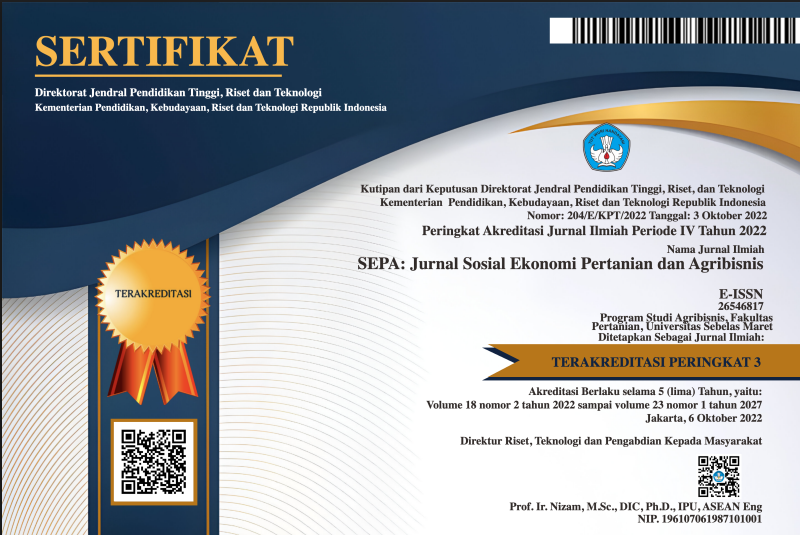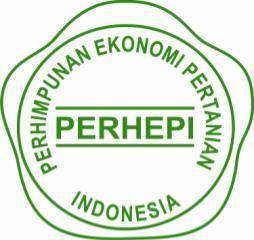PENGELOLAAN PENGGUNAAN PESTISIDA DALAM MENDUKUNG PEMBANGUNAN BERKELANJUTAN DI INDONESIA
Abstract
The use of pesticides in rice production has an impact on the environment. Pesticides are chemicals used to kill or control pests. The use of pesticides carries some risks, but farmers are used to using pesticides. However, the use of pesticides may lead to the contamination of groundwater. Therefore, the research question in this study was whether there any differences in rice production before and after pesticide reduction in Indonesia. This study aimed to analyze the difference between rice production before and after pesticide reduction in Indonesia. The secondary data in this study were rice production data from FAO. Data from 1968 to 1992 were data about rice production before reducing pesticide use in Indonesia, while data from 1993 to 2017 were data about rice production after reducing pesticide use in Indonesia. The applied data analysis was paired sample t-test using SPSS 25. The results indicated that there is a significant difference between rice production before and after reducing pesticide use in Indonesia.
Keywords
Full Text:
PDFReferences
Arif, A. (2015). Pengaruh bahan kimia terhadap penggunaan pestisida lingkungan. JF FIK UINAM, 3(4), 134–143.
Astuti, W., & Widyastuti, C. R. (2016). Pestisida organik ramah lingkungan pembasmi hama tanaman sayur. Rekayasa, 14(2), 115–120. https://doi. org/10.15294/rekayasa.v14i2.8970.
Mariyono, J. (2006). Kontribusi teknologi pengendalian hama terpadu pada penurunan penggunaan pestisida: Kasus produksi padi di Yogyakarta. Jurnal Matematika Sains Dan Teknologi, 7(2), 1285–138.
FAO. (2020). FAO publications catalogue 2020. Retrieved from https://doi.org/10. 4060/cb1512en.
Fitriadi, B. R., & Putri, A. C. (2016). Metode-metode pengurangan residu pestisida pada hasil pertanian. Jurnal Rekayasa Kimia & Lingkungan, 11(2), 61–71. https://doi.org/10.23955/rkl.v11i2.4950.
Jess, S., Kildea, S., Moody, A., Rennick, G., Murchie, A. K., & Cooke, L. R. (2014). European Union policy on pesticides: Implications for agriculture in Ireland. Pest Management Science, 70(11), 1646-1654. https://doi.org/10.1002/ps.3801.
Johnston, L., Davison, C., Lkhagvasuren, O., & Janes, C. R. (2019). Assessing the effects of a Canadian-Mongolian capacity building program for health and environmental impact assessment in the mining sector. Environmental Impact Assessment Review, 76, 61–68. https:// doi.org/10.1016/j.eiar.2019.01.002.
Las, I., Subagyono, K., Setiyanto, A. P., Besar, B., Dan, P., Sumberdaya, P., & Pertanian, L. (2006). Isu dan pengelolaan lingkungan dalam revitalisasi pertanian. Jurnal Penelitian Dan Pengembangan Pertanian, 25(3), 173–193.
Nkrumah, B. (2018). Edible backyards: climate change and urban food (in)security in Africa. Agriculture & Food Security, 7(1). https://doi.org/10.1186/s40066-018-0196-y.
Pretty, J. N. (2012). The Pesticide Detox: Towards a More Sustainable Agriculture. Oxford, England: Routledge.
Sachs, J. D., & McArthur, J. W. (2005). The millennium project: A plan for meeting the Millennium Development Goals. Lancet, 365(9456), 347–353. https://doi. org/10.1016/S0140-6736(05)70201-4.
Sekiyama, M., Tanaka, M., Gunawan, B., Abdoellah, O., & Watanabe, C. (2007). Pesticide usage and its association with health symptoms among farmers in rural villages in West Java, Indonesia. Environmental Sciences : An International Journal of Environmental Physiology and Toxicology, 14 Suppl, 23–33.
Sudarma, I. M., & As-syakur, A. R. (2018). Dampak perubahan iklim terhadap sektor pertanian di Provinsi Bali. SOCA: Jurnal Sosial Ekonomi Pertanian, 12(1), 87–98. https://doi.org/10.24843/soca.2018.v12.i01.p07.
Sukiyono, K. (2016). Faktor penentu tingkat efisiensi teknik usahatani cabai merah di Kecamatan Selupu Rejang, Kabupaten Rejang Lebong. Jurnal Agro Ekonomi, 23(2), 176–190. https://doi.org/10.21082/ jae.v23n2.2005.176-190.
United Nations. (2019). Empowering people and ensuring inclusiveness and equality Report of the Secretary-General. Retrieved from https://digitallibrary.un. org/record/3805750?ln=en
United Nations. (2012). Back to our Common Future: Sustainable Development in the 21st Century (SD21) project. Retrieved from http://sustainabledevelopment.un. org/content/documents/UNDESA_backDESA_Back_Common_Future_En.pdf.
Yuantari, M. G. C., Widiarnako, B., & Sunoko, H. R. (2013). Tingkat pengetahuan petani dalam menggunakan pestisida (studi kasus di Desa Curut Kecamatan Penawangan Kabupaten Grobogan). Prosiding Seminar Nasional Pengelolaan Sumberdaya Alam dan Lingkungan 2013.
Yuniastuti, A. (2018). Hubungan masa kerja, lama menyemprot, jenis pestisida, penggunaan APD dan pengelolaan pestisida dengan kejadian keracunan pada petani di Brebes. Public Health Perspective Journal, 2(2), 117–123.
Yusuf, M. N. (2011). Efisiensi teknis usahatani padi sawah (studi kasus pada kelompok tani Raksa Bumi III Desa Sindangsari Kecamatan Kawali Kabupaten Ciamis. Mimbar Agribisnis: Jurnal Pemikiran Masyarakat Ilmiah Berwawasan Agribisnis, 1(1), 85–94.
DOI: https://doi.org/10.20961/sepa.v18i1.47297
Refbacks
- There are currently no refbacks.



.png)







.png)
3.png)





